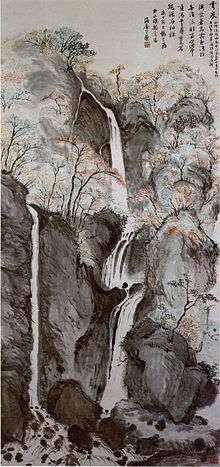Nukina Kaioku
Nukina Kaioku (貫名 海屋, 1778–1863) was a Japanese painter and calligrapher.[1] He had many pseudonyms, but Kaioku (海屋) and Sūō (菘翁) are well-known. He was called the top of calligraphy during the early-modern times. He was good at painting in the Nanga style, the Southern school of Chinese painting.

Early life
Nukina Kaioku was born on Shikoku in the Awa Province.[1] Nukina Kaioku was born into a samurai family of hereditary archery instructors to the daimyō of the Hachisuka clan of the Awa Province.[1] The typical samurai education included the martial arts, from which Kaioku's physical frailty exempted him, and Confucian philosophy, the Chinese classics, calligraphy and painting. He exhibited outstanding talent in calligraphy, and his uncle, who was a priest of the Kōyasan Shingon-shū on Mount Kōya, encouraged his interest in the writing style of Kūkai.
Legacy and style
By the end of his life Kaioku was recognized both as one of the outstanding calligraphers of his time and as a scholar of Chinese writing styles. Along with Maki Ryoko and Ichikawa Beian, he was one of the renowned calligraphers in groups of three referred to as Sanpitsu, or three brushes, during the Bakumatsu period (Bakumatsu no Sanpitsu).[1] His mature calligraphy style was conservative and fairly faithful to the orthodox tradition of the 4th-century Chinese master Wang Xizhi.[1] He was also versatile, and his calligraphy shows a solid mastery of the major modes of Kara-e (Chinese-style) writing.
References
- Murase, Miyeko. 1975. Japanese Art: Selections from the Mary and Jackson Burke Collection. Metropolitan Museum of Art. p. 284
| Wikimedia Commons has media related to Nukina Kaioku. |